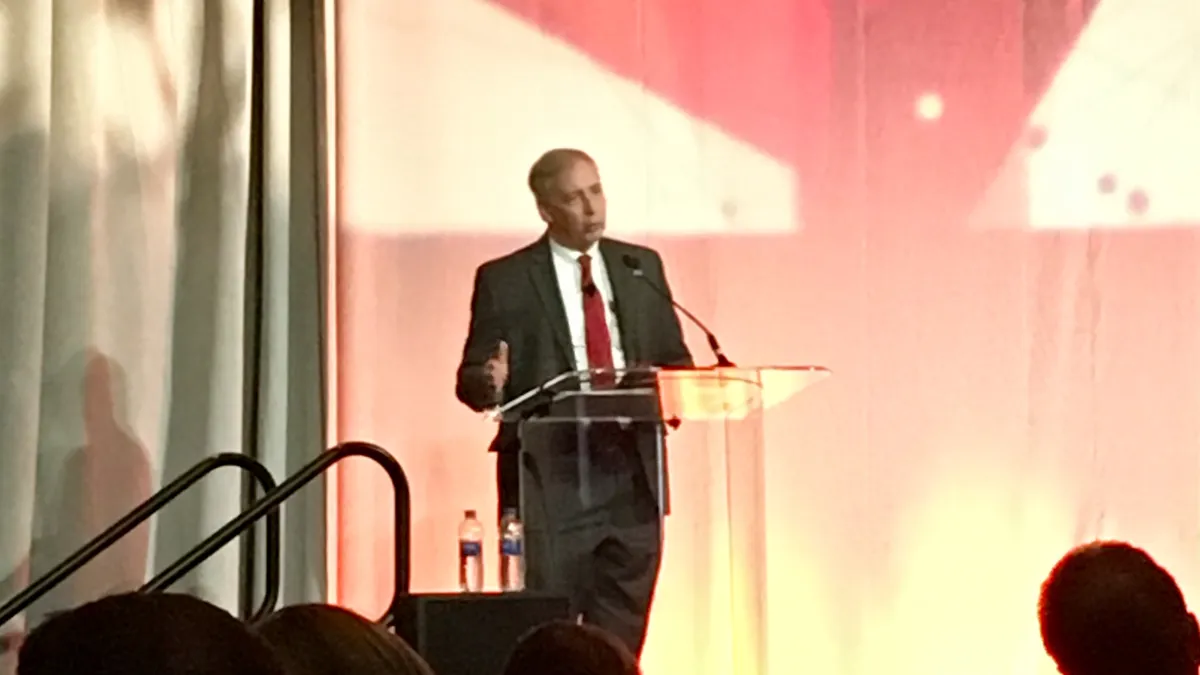Dive Brief:
- Total construction starts in 2019 will inch up to $808.3 billion from the $806.8 billion predicted for this year, according to the 2019 Dodge Construction Outlook report, which was released Thursday at Dodge Data & Analytics’ 80th annual Outlook Executive Conference in National Harbor, Maryland. In dollar terms, nonresidential building will stay at its current level, residential building will decrease 2% and nonbuilding construction (highways, bridges, environmental public works, etc.) will increase 3%, the report found.
- This stabilization comes on the heels of healthy double-digit increases ranging from 11% to 14% each year from 2012 through 2015, 7% increases in both 2016 and 2017, and a 3% increase estimated for this year, according to the report. While the construction industry faces growing headwinds in the form of rising interest rates and trade tensions, Chief Economist and VP of Economic Affairs Robert Murray said that the data does not yet signal a transition to decline. “The fundamentals continue to be sound, and I don’t think we’re going to be seeing a repeat of what took place back in 2008 and 2009,” he said at the event.
- Commercial building will see a square footage decreases in all categories — warehouse, office, hotel, store and shopping center — with overall value dragged down by the store construction sector, which has been disrupted by online retailers. The overall nonresidential estimates, however, are buoyed by expected growth in the institutional building sector (partly due to school construction bond measures passed in several states), manufacturing plant construction and public works construction.
Dive Insight:
The stock market’s slumps in the past several weeks have had many observers spooked, but while warning flags of a decline are beginning to appear in the form of a tightening labor market, rising inflation and other factors, economists at Dodge’s Outlook Executive Conference were confident that the industry will not be looking at a repeat of the 2008 financial crisis any time soon.
The U.S. economy’s momentum is currently the industry’s strongest tailwind, Murray said, with growth projected to hit 3.1% this year, according to the Congressional Budget Office. Easing up of lending standards for businesses and Dodd-Frank restrictions on mid-sized banks, which are often important for financing projects in local markets, have also helped fuel momentum forward, he added.
Meanwhile, President Donald Trump’s Tax Cuts and Jobs Act has yielded more of a mixed bag of results. Although Dodge attributed current growth in the U.S. economy and commercial building sector to the legislation, the report expects some of the benefits of these cuts to begin to fizzle out in 2019, returning the economy to a growth rate of about 2.5%.
As for headwinds, the trade war that’s brewing between the U.S. and China and resulting U.S. tariffs on $200 billion of Chinese goods have the potential to drive material prices up and increase inflationary pressures, many economists have noted.
In an analysis of U.S. Department of Labor data, the Associated General Contractors of America found that material prices rose almost 9% from May 2017 to May 2018, which is the biggest annual increase in seven years. This data did not yet factor in the 25% tariff on steel and 10% tariff on aluminum, which AGC expects will hurt construction, in particular, by causing budget overruns, project delays and even cancellations.
Regarding rising inflation, Dodge anticipates one more Federal Reserve interest rate hike by the end of the year to a range between 2.25% and 2.5%, as well as three to four quarter-point hikes next year, but the question analysts are considering, according to Murray, is: “Have [these rates] reached the threshold yet where they’re going to be cutting off construction?
"I don’t think it’s close to that point yet,” he said. “Basically, the levels of activity we’re expecting in 2019 are not that different than what we saw in 2018.”











